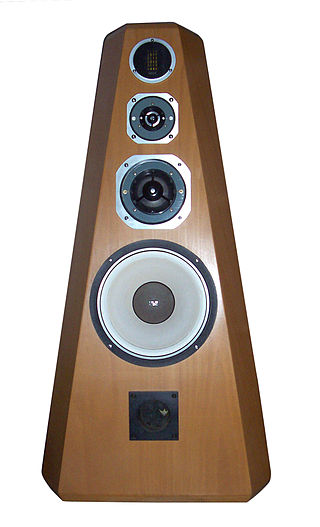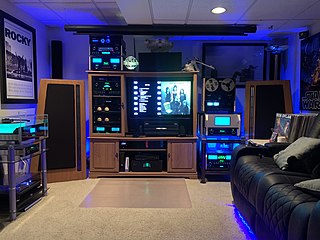Gallery
- Electronic Tube Tester, Model 625, ca. 1951
- FM Mono Tuner, Model HFT-90, ca. 1959
- Audio Amplifier, Model HF-12, ca. 1959
- Stereo Multiplex Autodaptor, Model MX99, ca. 1961
| Company type | Public |
|---|---|
| Industry | Electronics |
| Founded | 1945 in New York City, New York, U.S. |
| Founder | Harry Ashley |
| Defunct | 1999 |
| Headquarters | New York City, New York , U.S. |
| Products | Electronic kits |
EICO (an acronym for Electronic Instrument Company) was a manufacturer of electronics kits located in New York City, New York, United States.
EICO was established in New York City in 1945 by radio repair business owner Harry Ashley to manufacture electronic test equipment in kit form. His first product, advertised in the July 1946 Radio News, was the model 113 VTVM/audible signal tracer. [1] A wide variety of test equipment remained the company's mainstay during the time it was in the electronics business, however EICO often augmented their product lines with what was thought fashionable. For example, in the late 1940s it offered Geiger counters in response to public interest in uranium prospecting. Sales by December 1956 were said to be over one million instruments. Their largest secondary market was audio equipment. [2] Starting in 1958, EICO produced amateur radio equipment often in kit form, such as the EICO 720 and 730 transmitters. Later in the 1960s they made the EICO 753 SSB transceiver for amateur radio use. Unfortunately problems with the 753--or seven drifty three-- damaged their reputation which led to their decline. They also sold specialty test equipment for the ham radio market, including signal generators and grid dip oscillators. [3]
First located at 84 Withers Street in Brooklyn, New York, [4] and later at 33-00 Northern Boulevard in Long Island City, [5] EICO produced hi-fi products in the early 1950s to the mid-1960s with a line of tuners, preamplifiers, and amplifiers, available both in kit form or fully assembled. The model EICO HF-81 integrated tube amplifier is just one of several highly regarded products manufactured by EICO during this period. [6] EICO is also known for "monoblock" amplifiers such as the HF-50 and HF-35, stereo integrated amplifiers such as the ST-40 and ST-70, as well as many other amplifiers and preamplifiers.
In the late 1960s, EICO introduced a line of solid state electronics audio equipment referred to as Cortina, but by the mid-1970s the only audio products they sold were kits manufactured for them in South Korea. EICO left the audio market in the late 1970s and the electronics market some time later. EICO existed as a property management company until 1999, when the company was liquidated at the request of the shareholders. [2]

High fidelity is the high-quality reproduction of sound. It is popular with audiophiles and home audio enthusiasts. Ideally, high-fidelity equipment has inaudible noise and distortion, and a flat frequency response within the human hearing range.

An audio power amplifier amplifies low-power electronic audio signals, such as the signal from a radio receiver or an electric guitar pickup, to a level that is high enough for driving loudspeakers or headphones. Audio power amplifiers are found in all manner of sound systems including sound reinforcement, public address, home audio systems and musical instrument amplifiers like guitar amplifiers. It is the final electronic stage in a typical audio playback chain before the signal is sent to the loudspeakers.
Nakamichi Corp., Ltd. is a Japanese consumer electronics brand founded in Japan which gained a name from the 1970s onwards for audio cassette decks. Nakamichi is a subsidiary of Chinese holding company Nimble Holdings.

Heathkit is the brand name of kits and other electronic products produced and marketed by the Heath Company. The products over the decades have included electronic test equipment, high fidelity home audio equipment, television receivers, amateur radio equipment, robots, electronic ignition conversion modules for early model cars with point style ignitions, and the influential Heath H-8, H-89, and H-11 hobbyist computers, which were sold in kit form for assembly by the purchaser.

In electronics and radio, a tuner is a type of receiver subsystem that receives RF transmissions, such as AM or FM broadcasts, and converts the selected carrier frequency into a form suitable for further processing or output, such as to an amplifier or loudspeaker. A tuner is also a standalone home audio product, component, or device called an AM/FM tuner or a stereo tuner that is part of a hi-fi or stereo system, or a TV tuner for television broadcasts. The verb tuning in radio contexts means adjusting the receiver to detect the desired radio signal carrier frequency that a particular radio station uses. Tuners were a major consumer electronics product in the 20th century but in practice are often integrated into other products in the modern day, such as stereo or AV receivers or portable radios.
Lafayette Radio Electronics Corporation was an American radio and electronics manufacturer and retailer from approximately 1931 to 1981, headquartered in Syosset, New York, a Long Island suburb of New York City. The company sold radio sets, Amateur radio (Ham) equipment, citizens band (CB) radios and related communications equipment, electronic components, microphones, public address systems, and tools through their company owned and branded chain of retail outlets and by mail-order.

Sansui Electric Co., Ltd. was a Japanese manufacturer of audio and video equipment. Headquartered in Tokyo, Japan, it was part of the Bermuda conglomerate.
Harman Kardon is a division of US-based Harman International Industries, an independent subsidiary of Samsung Electronics. Harman Kardon was originally founded in Westbury, New York, in 1953 by business partners Sidney Harman and Bernard Kardon.

McIntosh Laboratory is an American manufacturer of handcrafted high-end audio equipment headquartered in Binghamton, New York. It is a subsidiary of McIntosh Group, which is under the ownership umbrella of Highlander Partners, a Dallas-based private equity firm.
Dynaco was an American hi-fi audio system manufacturer popular in the 1960s and 1970s for its wide range of affordable, yet high quality audio components. Founded by David Hafler and Ed Laurent in Philadelphia, Pennsylvania in 1955, it's best known product was the ST-70 tube stereo amplifier. They also manufactured other tube and solid state amplifiers, preamplifiers, radio tuners and bookshelf loudspeakers. Dynaco was liquidated in 1980, and the trademark is now owned by Radial Engineering Ltd.
Robert W. (Bob) Carver is an American designer of audio equipment based in the Pacific Northwest.

QUAD Electroacoustics is a British manufacturer of hi-fi equipment, based Huntingdon, England. QUAD is part of the IAG Group, with corporate headquarters located in Shenzhen, China.
Soundcraftsmen was a manufacturer of high-end audio stereo components located in Santa Ana, California, United States.
H. H. Scott, Inc. was a major manufacturer of hi-fi equipment in the U.S. It was founded in 1947 by Hermon Hosmer Scott in Cambridge, Massachusetts and moved to the nearby town of Maynard in 1957.
Luxman is a brand name of Japanese Luxman Corporation (ラックスマン株式会社) that manufactures luxury audio components. Luxman produces a variety of high-end audio products, including turntables, amplifiers, receivers, tape decks, CD players and speakers.

Fisher Electronics was an American company specialising in the field of hi-fi electronics. The company and the name was bought by Japanese electronics conglomerate Sanyo in 1975.
Technics is a Japanese audio brand established by Matsushita Electric in 1965. Since 1965, Matsushita has produced a variety of HiFi and other audio products under the brand name, such as turntables, amplifiers, radio receivers, tape recorders, CD players, loudspeakers, and digital pianos. Technics products were available for sale in various countries. The brand was originally conceived as a line of high-end audio equipment to compete against brands such as Nakamichi.
Carad was a brand of the Ets. G.L. Carpentier, a small Belgian electronics manufacturer located in Kuurne, near Kortrijk. It existed from 1925 to 1975. At the height of its activities around 1970, the company employed about 400 people.

Home audio refer to audio consumer electronics designed for home entertainment, such as integrated systems like shelf stereos, as well as individual components like loudspeakers and surround sound receivers.

The NAD 3020 is a stereo integrated amplifier by NAD Electronics, considered to be one of the most important components in the history of high fidelity audio. Launched in 1978, this highly affordable product delivered a good quality sound, which acquired a reputation as an audiophile amplifier of exceptional value. By 1998, the NAD 3020 had become the most well known and best-selling audio amplifier in history.